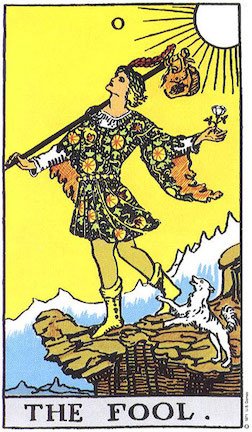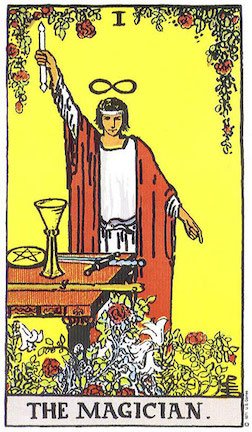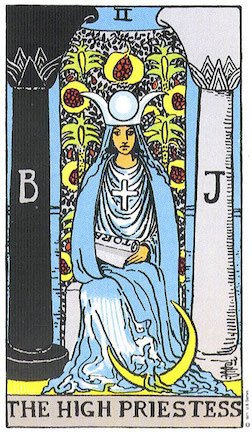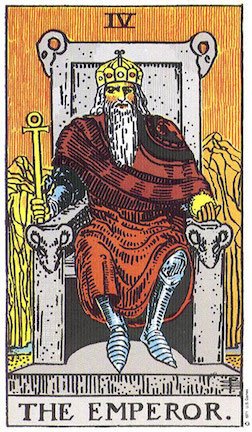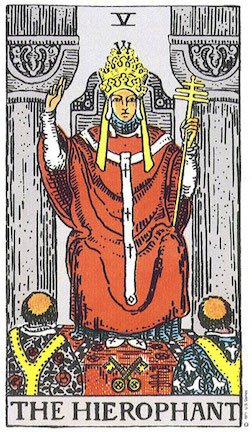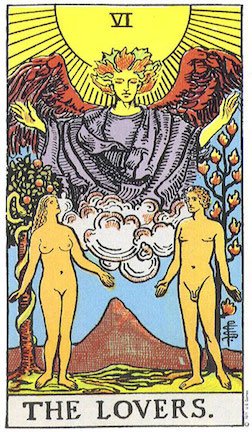The Fool’s Journey (Part 1)
The Fool’s Journey is a metaphor for Man’s journey through life, expressed pictographically through tarot cards. Each major arcana card stands for a stage on that journey; an experience that a person must incorporate to realize his wholeness.
The 22 descriptions given below tell us the story of the Fools’s Journey.
The information on this page comes from Joan Bunning. Take a look at the source on her site.
KEY 0 : THE FOOL
We begin with the Fool (0), a card of beginnings. The Fool stands for each of us as we begin our journey of life. He is a fool because only a simple soul has the innocent faith to undertake such a journey with all its hazards and pain.
At the start of his trip, the Fool is a newborn – fresh, open and spontaneous. The figure on Card 0 has his arms flung wide, and his head held high. He is ready to embrace whatever comes his way, but he is also oblivious to the cliff edge he is about to cross. The Fool is unaware of the hardships he will face as he ventures out to learn the lessons of the world.
The Fool stands somewhat outside the rest of the major arcana. Zero is an unusual number. It rests in the exact middle of the number system – poised between the positive and negative. At birth, The Fool is set in the middle of his own individual universe. He is strangely empty (as is zero), but imbued with a desire to go forth and learn. This undertaking would seem to be folly, but is it?
KEY I : THE MAGUS
On setting out, the Fool immediately encounters the Magus/Magician (1) and the High Priestess (2) – the great balancing forces that make up the perceived world. It is a feature of the material universe that as soon as we name some aspect of experience, we automatically evoke its opposite.
The Magician is the positive side. He represents the active, masculine power of creative impulse. He is also our conscious awareness. The Magician is the force that allows us to impact the world through a concentration of individual will and power.
KEY II : THE HIGH PRIESTESS
The High Priestess (2) is the negative side. She is the mysterious unconscious. She provides the fertile ground in which creative events occur. The High Priestess is our unrealized potential waiting for an active principle to bring it to expression.
The terms positive and negative do not imply “good” and “bad.” These are human distinctions that do not apply in the tarot. The Magician and the High Priestess are absolutely equal in value and importance. Each is necessary for balance. We may view the negative as our Shadow, but without shadows, we cannot see the light, and without a ground of potential, we cannot create.
KEY III : THE EMPRESS
As he grows, the Fool becomes more and more aware of his surroundings. As with most babies, he first recognizes his Mother – the warm, loving woman who nourishes and cares for him. He also comes to know Mother Earth, who nurtures him in a larger sense.
The Empress (3) represents the world of nature and sensation. A baby delights in exploring everything he touches, tastes and smells. He cannot get enough of the sights and sounds that enchant his senses. It is natural to delight in the abundant goodness of Mother Earth who surrounds us with her support.
KEY IV : THE EMPEROR
The next person the Fool encounters is the Father in the figure of the Emperor (4). He is the representative of structure and authority. As a baby leaves his mother’s arms, he learns that there are patterns to his world. Objects respond in predictable ways that can be explored. The child experiences a new kind of pleasure that comes from discovering order.
The Fool also encounters rules. He learns that his will is not always paramount and there are certain behaviors necessary for his well-being. There are people in authority who will enforce such guidelines. These restrictions can be frustrating but, through the patient direction of the Father, the Fool begins to understand their purpose.
KEY V : THE HIEROPHANT
Eventually, the Fool ventures out of his home into the wider world. He is exposed to the beliefs and traditions of his culture and begins his formal education. The Hierophant (5) represents the organized belief systems that begin to surround and inform the growing child.
A Hierophant is someone who interprets arcane knowledge and mysteries. On Card 5 we see a religious figure giving a blessing. Although this image is religious, it is really a symbol for initiations of all kinds.
The child is trained in all the practices of his society and becomes part of a particular culture and worldview. He learns to identify with a group and discovers a sense of belonging. He enjoys learning the customs of his society and showing how well he can conform to them.
KEY VI : THE LOVERS
Eventually, the Fool faces two new challenges. He experiences the powerful urge for sexual union with another person. Before, he was mainly self-centered. Now he feels the balancing tendency, pictured in the Lovers (6), to reach out and become half of a loving partnership. He yearns for relationship.
The Fool also needs to decide upon his own beliefs. It is well enough to conform while he learns and grows, but at some point, he must determine his own values if he is to be true to himself. He must start to question received opinion.
KEY VII : THE CHARIOT
By the time the Fool becomes an adult, he has a strong identity and a certain mastery over himself. Through discipline and will-power, he has developed an inner control which allows him to triumph over his environment.
The Chariot (7) represents the vigorous ego that is the Fool’s crowning achievement so far. On Card 7, we see a proud, commanding figure riding victoriously through his world. He is in visible control of himself and all he surveys. For the moment, the Fool’s assertive success is all he might wish, and he feels a certain self-satisfaction. His is the assured confidence of youth.

